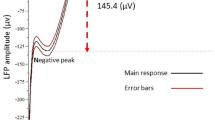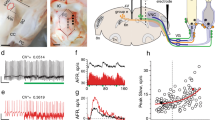Abstract
ALTHOUGH benzodiazepines are widely used psychotropic drugs their mode of action within the central nervous system (CNS) is controversial1–4. Based on biochemical and pharmacological investigations of various central and peripheral neural substrates, Costa et al.5 and Haefely et al.6 suggested that they act, at least in part, through a facilitation of γ-aminobutyric acid (GABA)-ergic transmission. We have tested this hypothesis electrophysiologically at the single unit level in areas of the CNS in which GABA has been unequivocally shown to be an inhibitory transmitter. Single unit recordings were made in neurones of the lateral vestibular nucleus (Deiters) and in Purkinje cells of the cerebellum.
This is a preview of subscription content, access via your institution
Access options
Subscribe to this journal
Receive 51 print issues and online access
$199.00 per year
only $3.90 per issue
Buy this article
- Purchase on Springer Link
- Instant access to full article PDF
Prices may be subject to local taxes which are calculated during checkout
Similar content being viewed by others
References
Fuxe, K., et al., in Mechanism of Action of Benzodiapines (edit. by Costa, E., and Greengard, P.), 45–61 (Raven, New York, 1975).
Padjen, A., and Bloom, F., in Mechanism of Action of Benzodiazepines (edit. by Costa, E., and Greengard, P.), 93–102 (Raven, New York, 1975).
Snyder, S. H., and Enna, F. I., in Mechanism of Action of Benzodiazepines (edit. by Costa, E., and Greengard, P.), 81–91 (Raven, New York, 1975).
Steiner, F. A., and Hummel, P., Int. J. Neuropharmacol, 7, 61–69 (1968).
Costa, E., Guidotti, A., Mao, C. C., and Suria, A., Life Sci., 17, 167–186 (1975).
Haefely, W., et al., in Mechanism of Action of Benzodiazepines (edit. by Costa. E., and Greengard, P.), 131–151 (Raven, New York, 1975).
Obata, K., Ito, M., Ochi, R., and Sato, N., Expl Brain Res., 4, 43–57 (1967).
Obata, K., and Takeda, K., J. Neurochem., 16, 1043–1047 (1969).
Curtis, D. R., Duggan, A. W., and Felix, D., Brain Res., 23, 117–120 (1970).
Curtis, D., and Felix, D., Brain Res., 34, 301–312 (1971).
Granit, R., and Phillips, C. G., J. Physiol., Lond., 133, 520–547 (1956).
Curtis, D. R., Duggan, A. W., Felix, D., and Johnston, G. A. R., Nature, 226, 1222–1224 (1970).
Steiner, F. A., Neurotransmitter und Neuromodulatoren (Thieme, Stuttgart, 1971).
Eccles, J. C., Sabah, N. H., Schmidt, R. F., and Táboriková, H., Expl Brain Res., 15, 498–520 (1972).
Author information
Authors and Affiliations
Rights and permissions
About this article
Cite this article
STEINER, F., FELIX, D. Antagonistic effects of GABA and benzodiazepines on vestibular and cerebellar neurones. Nature 260, 346–347 (1976). https://doi.org/10.1038/260346a0
Received:
Accepted:
Issue Date:
DOI: https://doi.org/10.1038/260346a0
This article is cited by
-
Pharmacology of GABA-mediated inhibition of spinal cord neurons in vivo and in primary dissociated cell culture
Molecular and Cellular Biochemistry (1981)
-
GABA-ergic mechanisms of cerebrovascular effects of phenazepam and diazepam
Bulletin of Experimental Biology and Medicine (1980)
-
A possible neuronal release of [14C] GABA from the rat cerebellum in vivo
Pfl�gers Archiv European Journal of Physiology (1979)
-
GABAergic modulation of benzodiazepine binding site sensitivity
Nature (1978)
-
Benzodiazepines specifically modulate GABA-mediated postsynaptic inhibition in cultured mammalian neurones
Nature (1978)
Comments
By submitting a comment you agree to abide by our Terms and Community Guidelines. If you find something abusive or that does not comply with our terms or guidelines please flag it as inappropriate.



